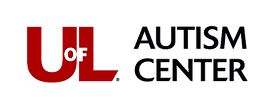Speech-language Pathology

Our expert team of speech-language pathologists provide specialized services in the area of feeding and augmentative and alternative communication (AAC) to children, teens, and young adults with autism spectrum disorders. According to the American Speech-Language-Hearing Association (ASHA), “A feeding or swallowing disorder includes developmentally atypical eating and drinking behaviors, such as not accepting age-appropriate liquids or foods, being unable to use age-appropriate feeding devices and utensils, or being unable to self-feed.”
The most current statistics state that up to 25% of typically developing children and up to 80% of children with developmental disabilities have feeding disorders (Manikam & Perman, 2000). Feeding disorders in children commonly derive from two components: oral motor based feeding deficits and behavioral based feeding deficits. Our multi-disciplinary feeding therapy team at the U of L Autism Center focuses on strengthening the oral-motor system with a combination of behavioral strategies, to increase the client’s safety and tolerance of a variety of foods and textures. Our ultimate goal is to make family mealtime enjoyable for the child and less stressful for the family. AAC refers to the use of a variety of methods, other than verbal speech, to communicate. A few examples of AAC include the use of gestures, pictures, typing, and speech generating devices. Clients with severe speech and/or language impairments may benefit from the use of AAC to functionally communicate their wants, needs, thoughts, and ideas. Speech-language therapy services at the U of L Autism Center are tailored to the individual and family needs, and may include consultation, comprehensive AAC evaluation, speech generating device trials (if indicated), parent/caregiver training, and ongoing individual and/or group treatment. Our speech-language pathologists take a team approach, working closely with other service providers to determine the communication system that best meets the needs of the client. We emphasize the importance of caregiver involvement and participation. Our ultimate goal is to train those closest to the client to implement essential strategies at home and in the community. We accomplish this by equipping the client and caregivers with the tools, knowledge, and supports needed to improve the clients’ ability to communicate and continue the journey of AAC across settings
